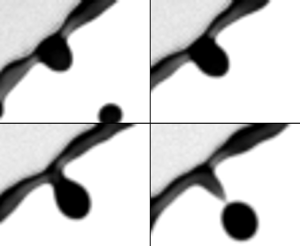Article contents
Growth and breakup of ligaments in unsteady fragmentation
Published online by Cambridge University Press: 18 January 2021
Abstract

We elucidate the physics underlying the birth, evolution and breakup of ligaments on a rim bounding an unsteady liquid sheet. This rim destabilizes into corrugations that can grow into ligaments, which in turn, break into secondary droplets via end-pinching. Combining experiments and theory, we show that not all corrugations can grow into ligaments. The number of corrugations is captured by linear instability coupled with nonlinear rim thickness self-adjustment ( $\text {Bond number} = 1 \text { criterion}$, Wang et al. (Phys. Rev. Lett., vol. 120, 2018, 204503)) and scales as
$\text {Bond number} = 1 \text { criterion}$, Wang et al. (Phys. Rev. Lett., vol. 120, 2018, 204503)) and scales as  $N_c \sim We^{3/4}$ with Weber number,
$N_c \sim We^{3/4}$ with Weber number,  $We$. The number of ligaments scales as
$We$. The number of ligaments scales as  $N_{\ell } \sim We^{3/8}$. The growth of a ligament is governed by the competition between the constraint imposed by the geometry of the local rim–ligament junction; the local force balance including the fictitious force from the continuously decelerating rim; and the global rim mass conservation constraint. The temporal evolution of the average width of ligaments is predicted. Key to understanding the ligament population, a minimum distance between two corrugations is required to enable their actual transition into ligaments. By predicting this minimal distance, we derive the evolution of the number of ligaments. We show that droplets are shed, one at a time, following a chaotic dripping end-pinching regime independent of
$N_{\ell } \sim We^{3/8}$. The growth of a ligament is governed by the competition between the constraint imposed by the geometry of the local rim–ligament junction; the local force balance including the fictitious force from the continuously decelerating rim; and the global rim mass conservation constraint. The temporal evolution of the average width of ligaments is predicted. Key to understanding the ligament population, a minimum distance between two corrugations is required to enable their actual transition into ligaments. By predicting this minimal distance, we derive the evolution of the number of ligaments. We show that droplets are shed, one at a time, following a chaotic dripping end-pinching regime independent of  $We$. Finally, the number of droplets shed per unit of time decreases over time and scales as
$We$. Finally, the number of droplets shed per unit of time decreases over time and scales as  $S_d \sim We^{3/4}$; while the volume shed per unit of time increases over time and is independent of
$S_d \sim We^{3/4}$; while the volume shed per unit of time increases over time and is independent of  $We$. Theoretical predictions are validated without fitting parameters.
$We$. Theoretical predictions are validated without fitting parameters.
JFM classification
- Type
- JFM Papers
- Information
- Copyright
- © The Author(s), 2021. Published by Cambridge University Press
References
REFERENCES
- 17
- Cited by





